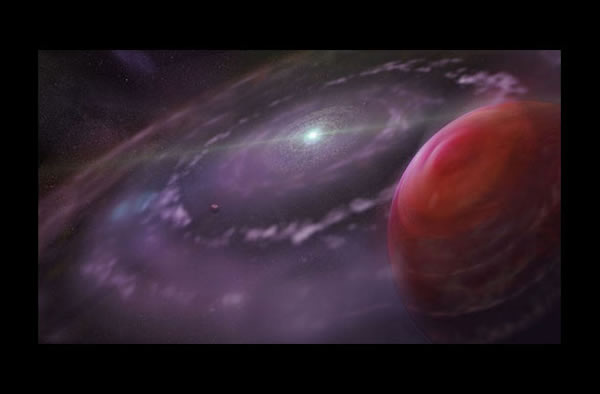Giant Alien Planet May Solve Mystery
Artist's rendering of the planetary system of HR 8799.
The glowing atmosphere of a strangely giant alien world could help solve mysteries of not just how it formed, but how our own solar system arose, scientists say.
The exoplanet discovery comes from the most detailed look yet at the alien planets around the distant star HR 8799, which lies about 130 light-years from Earth. The HR 8799 system is home to four giant planets orbiting a relatively young, 30-million-year-old star, with each planet far larger than any world found in Earth's solar system.
The planets orbiting HR 8799 weigh in at between five to 10 times the mass of Jupiter and are still glowing with the heat of their formation, allowing researchers to directly image them.
"It's the only system in which multiple planets can individually be seen," said study co-author Bruce Macintosh, an astronomer at Lawrence Livermore National Laboratory in California.
The planetary system resembles a scaled-up version of our solar system, suggesting there may be smaller Earth-size planets closer in, although the researchers currently have not yet seen any.
It even "has something that kind of looks like maybe an asteroid belt interior to the closest giant planet like we have in our solar system, and something that maybe you can refer to as an Oort cloud analog out beyond the most distant gas giant" — that is, a cloud of icy comets, said study lead author Quinn Konopacky, an astronomer at the University of Toronto. (Alien Planet Quiz: Are You an Exoplanet Expert?)
Exoplanet's atmosphere revealed
The astronomers concentrated on one of the star's visible planets, named HR 8799c, a colossal gas giant about seven times the mass of Jupiter. It circles the star HR 8799 at a range comparable to Pluto's distance from the sun.
The birth of such a massive planet at such a great distance from its parent star conflicts with the two popular models of planetary formation. In the multistep process known as core accretion, gas slowly accumulates onto a planetary core, while the mechanism known as gravitational instability involves the simultaneous creation of a planet's interior and atmosphere.
"In the traditional core accretion model of planet formation, it is difficult to form planets as large as the HR 8799 planets at such large distances from their parent star," Konopacky told SPACE.com. "Typically, in this model, objects the size of Jupiter or larger must form much closer to their parent star. This is for several reasons, but has a lot to do with there being less material at large distances from the star that can form planets."
"In the gravitational instability method of formation, it is possible to form big planets at large distances, usually because they invoke a much more massive disc of material," Konopacky added. "But the model generally predicts that there should be many more massive objects orbiting lots of other stars at these distances, and these kinds of objects have not been discovered in surveys (of many stars for exoplanets)."
To help solve this mystery, the scientists analyzed the glow from HR 8799c using a high-resolution imaging spectrograph called OSIRIS at the Keck Observatory in Hawaii. Molecules in atmospheres can absorb light, resulting in patterns known as spectra that allow scientists to identify what they are.
HR8799c is both fairly bright and located a fair distance from its star, helping the researchers acquire this spectral data for the most detailed examination yet of the atmosphere of a Jupiter-like planet beyond the solar system. [Birth of Giant Planet Seen? (Artist Animation)]
"The most exciting part of this result is that we were able to make these observations of an exoplanet atmosphere with this level of detail, much more than I even imagined was possible," Konopacky said. "We have broken the light from the planet down to such a fine level of detail that the chemical fingerprints of the molecules in the atmosphere are breathtakingly sharp and distinct. This is important because it requires data of this quality to truly probe the makeup of a planetary atmosphere, and in turn, say something about how the planet formed."
Mar 14, 2013 05:30 PM ET by Space.com












